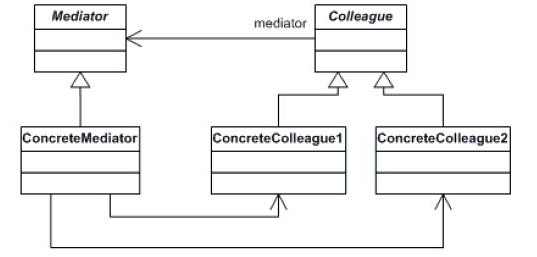设计模式(25)-----中介者模式
Posted 韩思明
tags:
篇首语:本文由小常识网(cha138.com)小编为大家整理,主要介绍了设计模式(25)-----中介者模式相关的知识,希望对你有一定的参考价值。
中介者(Mediator)
定义
用一个中介对象来封装一系列的对象交互。中介者使各对象不需要显式地相互引用,从而使其耦合松散,而且可以独立地改变它们之间的交互。
UML图

角色
Mediator:中介者接口。在里面定义了各个同事之间相互交互所需要的方法,可以是公共的方法,如Change方法,也可以是小范围的交互方法。
ConcreteMediator:具体的中介者实现对象。它需要了解并为维护每个同事对象,并负责具体的协调各个同事对象的交互关系。
Colleague:同事类的定义,通常实现成为抽象类,主要负责约束同事对象的类型,并实现一些具体同事类之间的公共功能,比如,每个具体同事类都应该知道中介者对象,也就是每个同事对象都会持有中介者对象的引用,这个功能可定义在这个类中。
ConcreteColleague:具体的同事类,实现自己的业务,需要与其他同事对象交互时,就通知中介对象,中介对象会负责后续的交互。
例子
联合国机构类 相当于Mediator类
package com.csdhsm.pattemdesign.mediator; /** * @Title: UnitedNations.java * @Description: 联合国机构类 相当于Mediator类 * @author: Han * @date: 2016年6月30日 下午7:46:59 */ public abstract class UnitedNations { public abstract void declare(String message, Country colleague); }
国家类 相当于Colleague类
package com.csdhsm.pattemdesign.mediator; /** * @Title: Country.java * @Description: 国家类 相当于Colleague类 * @author: Han * @date: 2016年6月30日 下午7:48:51 */ public abstract class Country { protected UnitedNations mediator; public Country(UnitedNations mediator) { this.mediator = mediator; } }
美国类 相当于ConcreteColleague1类
package com.csdhsm.pattemdesign.mediator; /** * @Title: USA.java * @Description: 美国类 相当于ConcreteColleague1类 * @author: Han * @date: 2016年6月30日 下午7:49:20 */ public class USA extends Country { public USA(UnitedNations mediator) { super(mediator); } public void declare(String message) { mediator.declare(message, this); } public void getMessage(String message) { System.out.println("美国获得对方信息: " + message); } }
伊拉克类 相当于ConcreteColleague2类
package com.csdhsm.pattemdesign.mediator; /** * @Title: Iraq.java * @Description: 伊拉克类 相当于ConcreteColleague2类 * @author: Han * @date: 2016年6月30日 下午7:49:33 */ public class Iraq extends Country { public Iraq(UnitedNations mediator) { super(mediator); } public void declare(String message) { mediator.declare(message, this); } public void getMessage(String message) { System.out.println("伊拉克获得对方信息: " + message); } }
联合国安理会 相当于ConcreteMediator类
package com.csdhsm.pattemdesign.mediator; /** * @Title: UnitedNationsSecurityCouncil.java * @Description: 联合国安理会 相当于ConcreteMediator类 * @author: Han * @date: 2016年6月30日 下午7:50:13 */ public class UnitedNationsSecurityCouncil extends UnitedNations { private USA colleague1; private Iraq colleague2; public void setColleague1(USA colleague1) { this.colleague1 = colleague1; } public void setColleague2(Iraq colleague2) { this.colleague2 = colleague2; } @Override public void declare(String message, Country colleague) { if(colleague == colleague1) { colleague2.getMessage(message); } else { colleague1.getMessage(message); } } }
客户端
package com.csdhsm.pattemdesign.mediator; public class Solution { public static void main(String[] args) { UnitedNationsSecurityCouncil UNSC = new UnitedNationsSecurityCouncil(); USA c1 = new USA(UNSC); Iraq c2 = new Iraq(UNSC); UNSC.setColleague1(c1); UNSC.setColleague2(c2); c1.declare("不准研制核武器,否则要发动战争!"); c2.declare("我们没有核武器,也不怕侵略。"); } }
结果

OK,成功。
总结
使用终结者模式的场合
1.一组定义良好的对象,现在要进行复杂的通信。
2.定制一个分布在多个类中的行为,而又不想生成太多的子类。
可以看出,中介对象主要是用来封装行为的,行为的参与者就是那些对象,但是通过中介者,这些对象不用相互知道。呵呵~~~
使用中介者模式的优点:
1.降低了系统对象之间的耦合性,使得对象易于独立的被复用。
2.提高系统的灵活性,使得系统易于扩展和维护。
使用中介者模式的缺点:
中介者模式的缺点是显而易见的,因为这个“中介“承担了较多的责任,所以一旦这个中介对象出现了问题,那么整个系统就会受到重大的影响。
以上是关于设计模式(25)-----中介者模式的主要内容,如果未能解决你的问题,请参考以下文章